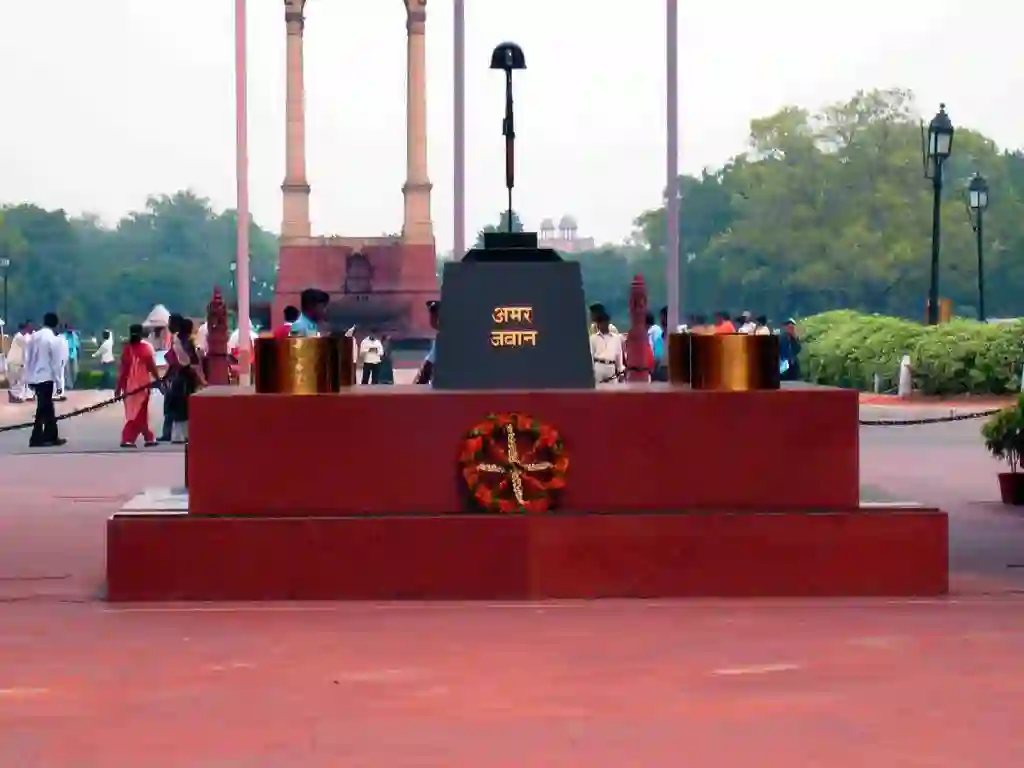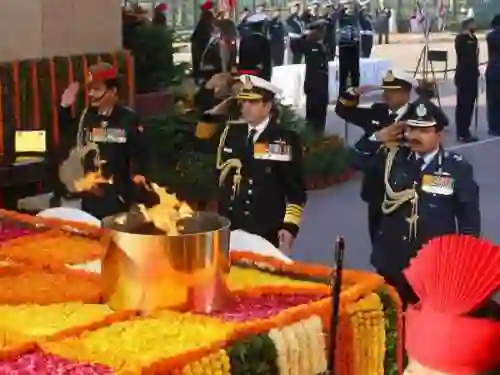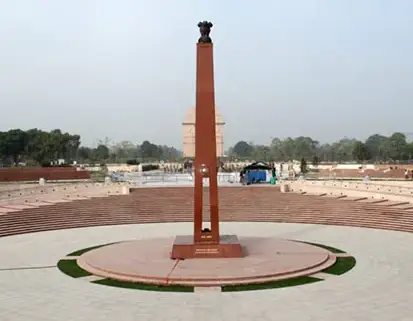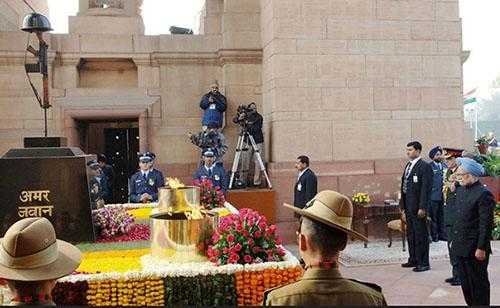
Amar Jawan Jyoti is a memorial in India. It was built after the Indo-Pak War in 1971 to honor the soldiers of the Indian armed forces who died during the war.
Who built Amar Jawan Jyoti? This memorial was built in December 1971 and inaugurated by prime minister Indira Gandhi in 1972.
Amar Jawan Jyoti

She honored the soldiers on India’s 23rd Republic Day. After that, it became customary for the prime minister and the president to visit the memorial on special occasions.
The Amar Jawan Jyoti is now in the inner ring called the Amar Chakra at the National War Memorial. The memorial has four circles that show a special form called a Chakravyuh. A tall structure called an obelisk stands in the center of the memorial. At the bottom of the obelisk, there is a flame that keeps burning.
Amar Jawan Jyoti History
Initially, The primary structure was constructed by Edwin Lutyens in 1921. It was added in 1971 under the India Gate.
India had a military confrontation with Pakistan during the liberation war in East Pakistan from 3rd December – 16 December.

In December 1971, Indira Gandhi, the prime minister of India, helped pay to construct the Indian memorial under the Indian gate to show respect for the dead and unknown soldiers who died fighting for the nation.
On 26 January 1972, officially inaugurated by Indira Gandhi. Since then, every year on republic day, before the annual parade, it has become customary for the prime minister and the president, and three heads of the armed forces to place a wreath and pay homage in honor of the soldiers.
Construction and Structure
It is India’s tomb for unknown soldiers. It consists of a marble cenotaph.

The Amar Jawan Jyoti was created quickly because Prime Minister Indira Gandhi wanted it ready for Republic Day on January 26, 1972. The time limit meant the memorial had to be small.
The memorial’s base was 15 square feet and stood 4 feet 3 inches tall. In the middle, there was a pedestal that was 3 feet 2 inches tall. On top of the pedestal, they placed a reversed rifle and a war helmet.
On each side of the main platform, there were urns with flames. The memorial was white back then.
Between 1971 and 2006, they used Liquified Petroleum Gas (LPG) cylinders to keep the flames burning. The pedestal had four urns, each with its burner. One LPG cylinder could fuel an urn for around 36 hours.
They stored the cylinders in a room inside the memorial. In December 2005, they switched to Piped Natural Gas (PNG), which is safer and cheaper.
The Amar Jawan Jyoti is now situated in the inner ring of the National War Memorial, known as Amar Chakra or Circle of Immortality. The memorial features a series of four concentric circles, resembling a pattern called Chakravyuh.
In the lower portion’s center, a tall structure called an obelisk housing the burning flame.

Amar Jawan Jyoti Timing
Being an eternal flame, the Amar Jawan Jyoti does not have a specific opening time and closing time.
The war memorial is located in India Gate, New Delhi, India, and is open for visitors every day of the week. The memorial is open 24 hours for visitors.
Amar Jawan Jyoti Address
The Amar Jawan Jyoti memorial, situated at India Gate in New Delhi, serves as a heartfelt tribute to the unwavering dedication and bravery of Indian soldiers.
It is a significant landmark and a popular destination for locals and tourists alike.
The memorial is located at J67H+5Q9, Kartavya Path, India Gate, New Delhi, Delhi 110001.

Celebration:
- The Indian Memorial in New Delhi hosts Republic Day on January 26. The ceremony honors Indian troops who died for independence.
- The Republic Day celebration at the Indian memorial begins with playing the national anthem, followed by the unfurling of the national flag.
- A 21-gun salute is then given to honor the fallen soldiers.
- The memorial receives an honor guard from the Indian Armed Forces. The guard marches with synchronized weapons. Martial music bands accompany the guard.
- Afterward, there is a ceremony called wreath-laying, where the Prime Minister or the President of India puts a wreath at the memorial to honor the soldiers who died.
- A two-minute silence usually follows this to honor the sacrifices made by the martyrs.
- Important people like high-ranking officials, members of the armed forces, and regular people from the community attend the ceremony.
- It reminds us in a strong and emotional way about how brave and selfless the soldiers were when they fought for India’s freedom and independence.
- The memorial hosts Kargil Vijay Diwas on 26 July and Army Day on 15 January, in addition to Republic Day.
Amar Jawan Jyoti merged with National War Memorial
Has Amar Jawan Jyoti shifted? So the answer is Yes.
On Friday, January 21, 2022, the flame of Amar Jawan Jyoti was combined with the everlasting flame at the National War Memorial. The government considered this a significant and historic event.
During a short ceremony, a part of the Indian Memorial flame was combined with the National War Memorial flame, located 400 meters away on the opposite side of India Gate. Air Marshal Balabadhra Radha Krishna, the head of Integrated Defence Staff, oversaw the ceremony.
How to reach Amar jawan jyoti
It is situated on Kartavya Path, India Gate, New Delhi. It is 13.5 km far from Delhi Airport. You can use public transport or cab services to reach the place.
New Delhi Railway Station is less far from Amar jawan jyoti than the Delhi airport. Its distance from the railway station is 4 km.
Nearby Places to Visit
Amar Jawan Jyoti is a memorial in Delhi that honors the brave soldiers who died in the Indian Armed Forces. It is located near India Gate, a popular place for tourists to visit.
Near Amar Jawan Jyoti Memorial, you can visit:
- India Gate
- Rashtrapati Bhawan
- National Gallery of Modern Art
- Jantar Mantar
- National Museum
- Akshardham Temple
India Gate
India Gate is a famous monument located in the center of New Delhi. Its represents India’s rich history and culture. It was unveiled on 12 Feb 1931.
It is a way of paying tribute and showing admiration for the brave soldiers who gave up their lives during the Third Afghan War and First World War.
The architect, Sir Edwin Lutyens, designed this tall and impressive archway made of red sandstone. It is 42 meters high and has beautiful carvings and writings.
Rashtrapati Bhawan
Rashtrapati Bhawan is located in New Delhi, India, where the President of India lives. It is a big and impressive building showing India’s political history. The famous architect Sir Edwin Lutyens designed it by combining different styles of architecture, both Indian and European.
Rashtrapati Bhawan looks majestic and has beautiful details, representing India’s rich culture. Around the building, there are lovely Mughal Gardens where people can relax and enjoy the peaceful surroundings.
Rashtrapati Bhawan is not just a home but also a place where important ceremonies and administrative work occur. It is very important for the governance and history of the country.
National Gallery of Modern Art
Museum in New Delhi that shows different types of modern and contemporary artwork from India and other countries. It is in a beautiful old building in New Delhi. It is the best place to go if you love art.
Visitors can see many kinds of artworks like paintings, sculptures, photographs, and installations made by famous artists. The museum is important for promoting and protecting India’s art history, giving artists a chance to express themselves and share ideas.
It has exhibitions and programs that help people learn about and enjoy modern art.
Jantar Mantar
Jantar Mantar in Delhi is a fascinating place with a long history. Maharaja Jai Singh II built it during the 1700s and has special tools made of stone. The main objective of the observatory was to create astronomical tables and forecast the timings and movements of the sun, moon, and planets.
Jantar Mantar shows India has a strong science tradition and building skills. People can visit this amazing site to learn about old methods of studying the stars and see how cleverly the tools were made.
National Museum
The National Museum of India in New Delhi is an important institution dedicated to safeguarding and displaying the country’s diverse cultural heritage.
Housing an extensive collection that spans over 5,000 years, the museum takes visitors on a captivating journey through India’s art, archaeology, and cultural artifacts.
Guests can explore various exhibits, including ancient sculptures, paintings, textiles, coins, and jewelry, offering insights into India’s rich history and artistic practices.
The National Museum acts as a valuable source of knowledge, deepening one’s understanding of India’s history, religions, and societal traditions.
Through educational programs, exhibitions, and interactive displays, the museum provides an engaging experience for individuals of all ages, fostering cultural appreciation and instilling a sense of national pride.
Akshardham Temple
Akshardham Temple is a famous Hindu temple complex in Delhi that attracts many tourists. It is known for its beautiful art, spirituality, and importance to Indian culture. The temple had its official opening on November 6, 2005, under the leadership of Pramukh Swami Maharaj.
Several distinguished guests attended the ceremony, including A. P. J. Abdul Kalam, Manmohan Singh, L.K Advani, and B.L Josh.
The main temple is dedicated to Lord Swaminarayan and provides a peaceful place for people to pray and meditate. The temple also has exhibits that teach about the history and beliefs of Hinduism. Visitors can enjoy amazing light, and sound shows that tell ancient Indian tales.
Nearby Hotels of Amar Jawan Jyoti Delhi
Best Time to Visit Amar jawan jyoti
Delhi’s Amar Jawan Jyoti, a memorial to Indian troops, is open year-round. To improve your experience, consider some criteria. Due to cooler temperatures and agreeable days, October through March is the greatest season to visit Delhi’s, Amar Jawan Jyoti.
If you want a peaceful visit, avoid weekends and holidays. Remember to respect and follow the rules when paying tribute to the gallant troops at the Amar Jawan Jyoti.
FAQs
The Indian Memorial is now at the inner ring of the National War Memorial, called the Amar Chakra or Circle of Immortality. The Memorial has four circles that look like a maze and a tall pillar in the center with a flame burning at the bottom.
India’s fallen warriors are memorialized at Jaipur. The memorial in Jan Path, Jaipur, symbolizes national pride and appreciation for troops who died to defend the nation. Many people visit the memorial to honor the fallen warriors.
In 1972, a special place was built beneath India Gate to honor India’s victory over Pakistan in the Indo-Pakistani War in 1971. This war led to the creation of Bangladesh.
LPG cylinders fueled the memorial flame from 1971 to 2006. The memorial’s base has four urns with burners. Each LPG cylinder burned one urn for 36 hours. PNG was safer and cheaper, so they switched in December 2005.
These are some famous restaurants near this memorial
Amar Jyoti Restaurant
House of Ming
Chicken Inn
Have More
Ba Ni Rasoi
Wasabi by Morimoto
It has burned continuously for nearly 50 years. Piped natural gas (PNG) replaced Liquefied Petroleum Gas (LPG) cylinders in 2006. The flame joins the India Gate National War Memorial ablaze.
You can also read:







nice
There will hardly be a Delhite who hasn’t visited India Gate. It’s a beautiful picnic spot and Amar Jawan Jyoti gives real patriotic feel. I love this place.
Nice informative post
Like it
Thank you .